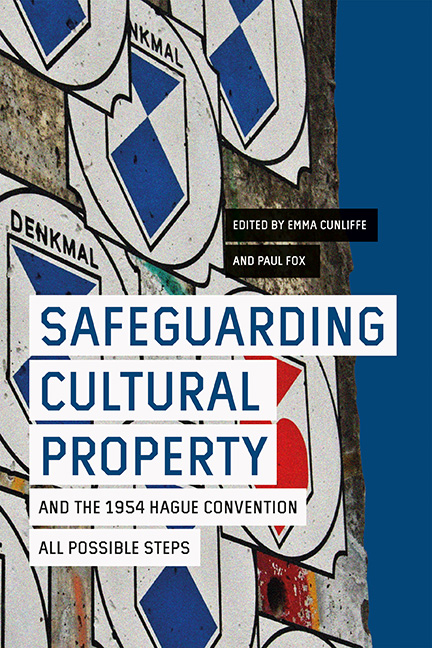Book contents
- Frontmatter
- Contents
- List of Illustrations
- List of Contributors
- Plate Section
- Acknowledgements
- List of Abbreviations
- Preface: The Blue Shield and the Protection of the World's Cultural Property – Preparing in Peace for Conflict
- Part I Safeguarding – Reassessing the Field
- Part II Historical Perspectives
- Part III Current Issues in Legal Implementation
- Part IV The Hague Convention in Practice Today: Tools and Approaches
- Appendix 1 The Hague Convention for the Protection of Cultural Property in the Event of Armed Conflict with Regulations for the Execution of the Convention 1954
- Appendix 2 Regulations for the Execution of the Convention for the Protection of Cultural Property in the Event of Armed Conflict
- Appendix 3 Resolutions of the 1954 Hague Conference
- Appendix 4 Second Protocol to the Hague Convention of 1954 for the Protection of Cultural Property in the Event of Armed Conflict 1999
- Appendix 5 Additional Protocols (1977) to the Geneva Conventions (1949) (Extracts)
- Index
- HERITAGE MATTERS
5 - Safeguarding Measures and the Interplay between the 1954 Hague Convention, its 1999 Second Protocol, and the 1972 World Heritage Convention
Published online by Cambridge University Press: 26 May 2022
- Frontmatter
- Contents
- List of Illustrations
- List of Contributors
- Plate Section
- Acknowledgements
- List of Abbreviations
- Preface: The Blue Shield and the Protection of the World's Cultural Property – Preparing in Peace for Conflict
- Part I Safeguarding – Reassessing the Field
- Part II Historical Perspectives
- Part III Current Issues in Legal Implementation
- Part IV The Hague Convention in Practice Today: Tools and Approaches
- Appendix 1 The Hague Convention for the Protection of Cultural Property in the Event of Armed Conflict with Regulations for the Execution of the Convention 1954
- Appendix 2 Regulations for the Execution of the Convention for the Protection of Cultural Property in the Event of Armed Conflict
- Appendix 3 Resolutions of the 1954 Hague Conference
- Appendix 4 Second Protocol to the Hague Convention of 1954 for the Protection of Cultural Property in the Event of Armed Conflict 1999
- Appendix 5 Additional Protocols (1977) to the Geneva Conventions (1949) (Extracts)
- Index
- HERITAGE MATTERS
Summary
The present contribution aspires to shed light on the complex interplay between three very topical international legal instruments regarding safeguarding measures affording protection to cultural property and cultural heritage: the United Nations Educational, Scientific and Cultural Organization (UNESCO) 1954 Convention on the Protection of Cultural Property in the Event of Armed Conflict (‘the 1954 Convention’), the Second Protocol to the Hague Convention of 1954 for the Protection of Cultural Property in the Event of Armed Conflict (1999 Second Protocol),and the 1972 Convention for the Protection of the World Cultural and Natural Heritage (World Heritage Convention). Through the use of appropriate examples, it further intends to demonstrate how these safeguarding measures have been utilised in practice, while bringing into relief their potential and shortcomings.
At first, I provide the definitions of the terms ‘cultural property’ and ‘cultural heritage’, as found in the above international treaties, the objective being to showcase their points of inter-section and divergence. Having defined the object of protection, I then move on to outline the required safeguarding measures that states parties to these treaties are obliged to adopt in relation to an armed conflict. In the following section, I consider the interaction between the special protection regime established by the 1954 Convention, the system of enhanced protection of the 1999 Second Protocol, and the World Heritage Convention. The underlying rationale of this inquiry is to identify the synergies and the discrepancies in this intricate web of differing protective regimes that are available to cultural property, while aiming to determine their practical utility. The last part concludes.
UNPACKING THE CONCEPTS OF CULTURAL PROPERTY AND CULTURAL HERITAGE
In the present section, I define the object of consideration, given the all-too-often confusion that the distinction between the concepts of cultural property and cultural heritage provokes. It is important to clarify at the outset that cultural property in all of its manifestations forms part of the cultural heritage of humankind. By means of comparing the two concepts under consider-ation, it has been argued that cultural property ‘looks for an owner and assesses everything from that standpoint, rather than looking to the preservation of the cultural heritage itself ‘ (Prott & O’Keefe 1992, 314).
- Type
- Chapter
- Information
- Safeguarding Cultural Property and the 1954 Hague ConventionAll Possible Steps, pp. 97 - 112Publisher: Boydell & BrewerPrint publication year: 2022



